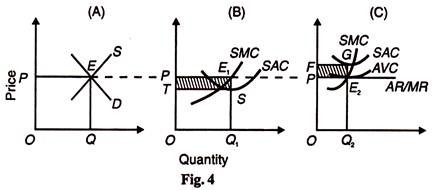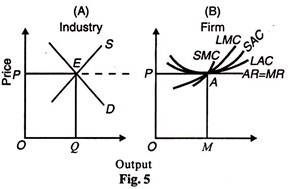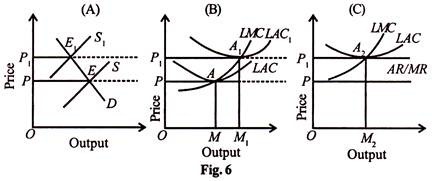In this article we will discuss about the equilibrium of the perfectly competitive industry.
Conditions of Equilibrium of the Perfectly Competitive Industry:
An industry is in equilibrium:
(i) When there is no tendency for the firms either to leave or enter the industry, and
(ii) When each firm is also in equilibrium.
ADVERTISEMENTS:
The first condition implies that the average cost curves coincide with the average revenue curve of all the firms in the industry. They are earning only normal profits, which are supposed to be included in the average cost curves of the firms. The second condition implies the equality of MC and MR. Under a perfectly competitive industry, these two conditions must be satisfied at the point of equilibrium, i.e.,
Short-Run Equilibrium of the Perfectly Competitive Industry:
An industry is in equilibrium in the short run when its total output remains steady, there being no tendency to expand or contract its output. If all firms are in equilibrium, the industry is also in equilibrium.
For full equilibrium of the industry in the short run, all firms must be earning only normal profits. The condition for this is SMC = MR = AR = SAC. But fall equilibrium of the industry is by sheer accident because in the short run some firms may be earning supernormal profits and some incurring losses.
ADVERTISEMENTS:
Even then, the industry is in short-run equilibrium when its quantity demanded and quantity supplied are equal at the price which clears the market. This is illustrated in Figure 4, where in Panel (A), the industry is in equilibrium at point E where its demand curve D and supply curve S intersect which determine OP price at which its total output OQ is cleared.
But at the prevailing price OP some firms are earning supernormal profits PE1ST as shown in Panel (B), while some other firms are incurring FGE2P losses as shown in Panel (C) of the figure.
Long-Run Equilibrium of the Perfectly Competitive Industry:
The industry is in equilibrium in the long run when all firms earn normal profits. There is no incentive for firms to leave the industry or for new firms to enter it. With all factors homogeneous and given their prices and the same technology, each firm and industry as a whole are in full equilibrium where LMC = MR = AR (=P) = LAC at its minimum.
ADVERTISEMENTS:
Such an equilibrium position is attained when the long-run price for the industry is determined by the equality of total demand and supply of the industry. The long-run equilibrium of the industry is illustrated in Figure 5(A) where the long-run price op and OQ output are determined by the intersection of the demand curve D and the supply curve S at point E.
At this price op, the firms are in equilibrium at point A in Panel (B) at OM level of output where LMC = SMC = MR = P (=AR) = SAC = LAC at its minimum. At this level, the firms are earning normal profits and have no incentive to enter or leave the industry.
It follows that when the industry is in long-run equilibrium, each firm in the industry is also in long- run equilibrium. If both the industry and the firms are in long-run equilibrium, they are also in short-run equilibrium.
Even though all firms in a perfectly competitive industry in the long run have the same cost curves, the firms can be of different efficiency. Firms using superior resources or inputs such as superior management must pay them higher rewards, otherwise they will shift to new firms which offer them higher prices.
So the forces of competition will force the more efficient firms to pay superior resources higher prices at their opportunity cost. As a result, the lac curve of the more efficient firms will shift upwards and they will benefit in the form of higher output at the higher long-run equilibrium price set by the industry.
Unable to pay higher prices to resources or inputs, less efficient firms will be competed away. New firms which are able to pay more and attracted by the new higher market price will enter the industry. But at the new long-run equilibrium price of the industry, all firms will be producing at the minimum lac.
This is illustrated in Figure 6 where the industry is in initial equilibrium at point E with price op in Panel (A) and the more efficient firms like all other firms are in equilibrium at point A in Panel (B). As the industry is in equilibrium, the new firms do not exist as they are not in a position to cover their costs at OP price.
When the more efficient firms pay higher prices to resources or inputs, their LAC curve rises to LAC1. At the new long-run equilibrium price of the industry set at OP1 the more efficient firms are in equilibrium where P1 = LAC1 at its minimum point A1 in Panel (B).
ADVERTISEMENTS:
They are now producing larger output OM1 even though they earn normal profits. The new firms also earn normal profits at point A2, as shown in Panel (C). But they produce less output OM2 than OM1 produced by the more efficient firms.



